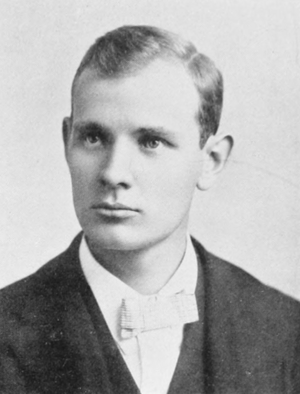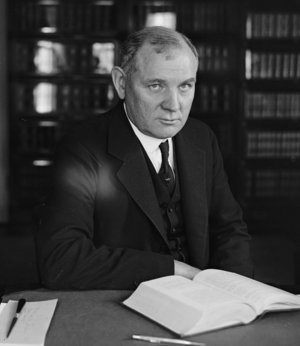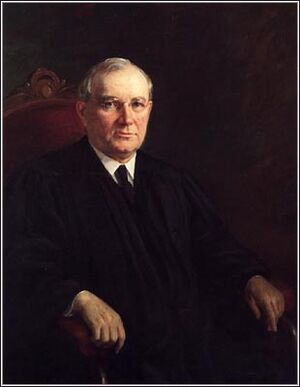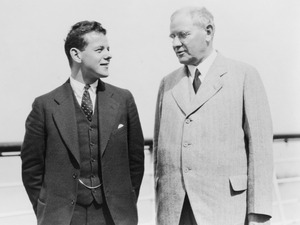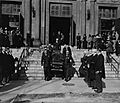Pierce Butler (judge) facts for kids
Quick facts for kids
Pierce Butler
|
|
|---|---|
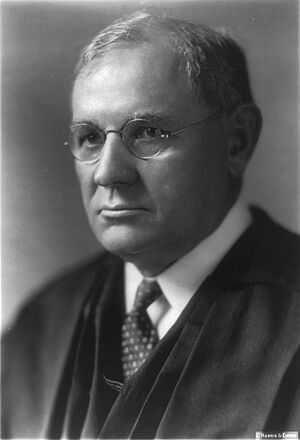
Butler c. 1922
|
|
| Associate Justice of the Supreme Court of the United States | |
| In office January 2, 1923 – November 16, 1939 |
|
| Nominated by | Warren G. Harding |
| Preceded by | William R. Day |
| Succeeded by | Frank Murphy |
| Personal details | |
| Born | March 17, 1866 Dakota County, Minnesota, U.S. |
| Died | November 16, 1939 (aged 73) Washington, D.C., U.S. |
| Resting place | Calvary Cemetery |
| Political party | Democratic |
| Spouse |
Annie Cronin
(m. 1891) |
| Children | 1 |
| Education | Carleton College (BA, BS) |
| Signature | |
Pierce Butler (born March 17, 1866 – died November 16, 1939) was an American judge. He served as an Associate Justice of the Supreme Court of the United States from 1923 until he passed away in 1939. He was known for his strong conservative views. People saw him as part of the "Four Horsemen." This was a group of four conservative judges who were very powerful in the Supreme Court during the 1930s. He was a devoted Catholic. He was also the only judge who disagreed with the final decision in the case Buck v. Bell, though he did not write down his reasons.
Contents
Early Life and Education
Pierce Butler was born in Northfield, Minnesota. His parents were Patrick and Mary Ann Butler. He was born in a log cabin and was the sixth of nine children. All but one of his sisters lived to be adults. His parents were Catholic immigrants from County Wicklow, Ireland. They had met in Galena, Illinois. They left Ireland because of a terrible event called the Great Famine. This was a time when many people in Ireland faced starvation.
Butler finished his studies at Carleton College in 1887. He earned two degrees, one in arts and one in science. After college, he studied law for one year. This was a common way to become a lawyer back then. He was then allowed to practice law in 1888. He married Annie M. Cronin in 1891.
His Legal Career
In 1892, Butler was chosen as the county attorney for Ramsey County, Minnesota. He was re-elected for this job in 1894. In 1896, Butler joined a law firm called How & Eller. After one of the partners passed away, the firm became How & Butler. He decided to practice law in St. Paul, Minnesota. There, he handled legal cases for railroads, especially for a company owned by James J. Hill. He was very good at representing these railroad companies.
In 1905, he went back to working as a private lawyer. He rejoined his former partner, Jared How. He also worked as a lawyer for a company owned by his five brothers. In 1908, Butler was elected President of the Minnesota State Bar Association. This is a group for lawyers in Minnesota.
From 1912 to 1922, he worked on railroad law in Canada. He represented both the owners of railroad companies and the Canadian government. He achieved good results for both sides. When he was chosen for the United States Supreme Court in 1922, he was in the middle of winning about $12 million for the owners of the Toronto Street Railway.
On the Supreme Court
Becoming a Justice
On December 5, 1922, President Warren G. Harding nominated Pierce Butler. This meant he officially suggested Butler to become an associate justice of the Supreme Court. He was chosen to take the place of William R. Day.
Even though the top judge, Chief Justice William Howard Taft, supported him, Butler faced some challenges. He had been against "radical" and "disloyal" professors at the University of Minnesota. He had served on the university's Board of Regents. This made his nomination a bit controversial. Some politicians and groups were against him. These included Senator-elect Henrik Shipstead and Senator Robert M. La Follette. Labor activists and some liberal magazines also opposed him. Even the Ku Klux Klan was against him because he was Catholic.
However, many people supported his appointment. These included important Roman Catholics, other lawyers (the Minnesota State Bar Association strongly backed him), and business groups, especially railroad companies. Minnesota's senators, Knute Nelson and Frank B. Kellogg, also supported him. The United States Senate confirmed Butler on December 21, 1922. This means they voted to approve him. The vote was 61 to 8. He officially started his job on January 2, 1923.
His Time on the Court
As a Supreme Court justice, Butler strongly disagreed with the government controlling businesses. He also opposed federal welfare programs. He believed these programs were against the Constitution. During the Great Depression, a time of great economic hardship, he ruled against many "New Deal" laws. These laws, like the Agricultural Adjustment Administration and the National Recovery Administration, were supported by President Franklin D. Roosevelt. Because of his strong views, he became known as one of the "Four Horsemen." The other judges in this group were James Clark McReynolds, George Sutherland, and Willis Van Devanter.
During his sixteen years on the Supreme Court, Justice Butler wrote 327 opinions that were supported by the majority of the judges. He also wrote 50 opinions where he disagreed with the majority.
He wrote the main opinion in the case United States v. Schwimmer. In this case, a woman from Hungary was denied citizenship. This was because she refused to promise to "take up arms" (fight) for her new country.
In the case Palko v. Connecticut, Butler was the only judge who disagreed. The other judges thought that a state could try a person a second time for the same crime. This is called double jeopardy. Butler believed this went against the Fourteenth Amendment to the United States Constitution. This amendment helps protect people's rights.
He agreed with the majority in Pierce v. Society of Sisters. In this case, the Court decided that an Oregon state law was unconstitutional. This law had tried to stop parents from sending their children to private or religious schools.
Another important time he disagreed was in the case Olmstead v. United States. The Court decided that federal wiretapping was allowed. Wiretapping is secretly listening to phone calls. Butler believed that this went against the Fourth Amendment. This amendment protects people from unreasonable searches.
Death and Legacy
On November 15, 1939, Butler went to a Washington, D.C. hospital for a small health issue. He passed away early on November 16, at 73 years old. He was still serving on the Supreme Court when he died. He was the last Supreme Court Justice who had been appointed by President Harding. He is buried in Calvary Cemetery in St. Paul, Minnesota.
Most of his and his family's important papers are kept at the Minnesota Historical Society. Other papers are stored in different places.
A road in Saint Paul, Minnesota, called Pierce Butler Route, is named after his son, Pierce Butler Jr.
Images for kids
-
Funeral of Justice Pierce Butler. Members of the Supreme Court are standing on the right. From left to right, they are retired Justice Willis Van Devanter, Justices Felix Frankfurter, Hugo Black, Harlan Stone; Chief Justice Charles Evans Hughes and Thomas E. Waggaman, Marshal of the United States Supreme Court. They are following a special church service at St. Matthew's Cathedral. Standing on the left, from left to right, are Justices Owen J. Roberts, Stanley Forman Reed, William O. Douglas, and retired Justice George Sutherland.
-
The Butler family grave plot in St. Paul, Minnesota. It is marked by a large stone obelisk that only says "BUTLER." Pierce's gravestone is in the front, partly hidden by tall grass.


